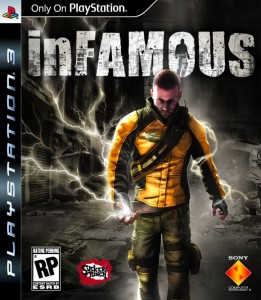written by Melissa Shaw
 In 2002, Sucker Punch Productions came out with a cartoonish children’s game for the PS2 called Sly Cooper and the Thievious Raccoonus, the first of a trio of Sly Cooper games. The title character was a thief who snuck around cities, climbed up buildings, and ran across wires. Sly’s loyal companions gave him intel and assigned him capers over a radio connection. The various games in the series featured elements like a villain dumping tar into the water supply, our hero following specific NPCs through a city without being spotted, and a blimp filled with “spice” gas whose evil purpose was to drive a city’s denizens insane.
In 2002, Sucker Punch Productions came out with a cartoonish children’s game for the PS2 called Sly Cooper and the Thievious Raccoonus, the first of a trio of Sly Cooper games. The title character was a thief who snuck around cities, climbed up buildings, and ran across wires. Sly’s loyal companions gave him intel and assigned him capers over a radio connection. The various games in the series featured elements like a villain dumping tar into the water supply, our hero following specific NPCs through a city without being spotted, and a blimp filled with “spice” gas whose evil purpose was to drive a city’s denizens insane.
Fast-forward to 2009, and InFamous, Sucker Punch’s new action-adventure game whose main character, Cole, prowls around a city, climbs up buildings, and runs across wires. His companions — some friendly, some hostile — give him intel and assign him capers over a cell phone. Some game elements include a villain dumping tar into the water supply, our hero following specific NPCs through the city without being spotted, and several zeppelins filled with toxic gas whose evil purpose is drive the city’s denizens insane.
To be fair, both the Sly Cooper series and InFamous are highly entertaining, and both offer a great deal more than just those similarities. But the family resemblance is striking enough to make you wonder why Sucker Punch felt so comfortable blatantly ripping off its own games, and why they didn’t at least file off the serial numbers and change enough details to make those familiar elements seem fresher. Maybe they didn’t expect any overlap in the audiences of the two games; InFamous is certainly a far more grown-up and darker game. Where the Sly Cooper games felt like bubblegum comics, InFamous has the feel of a graphic novel. (The Sucker Punch games also share a stylized form of cut-scenes made up of largely still images, with a voiceover narrative.)
The premise of InFamous is that Cole survives a bomb explosion that imbues him with various electrical powers: shooting lightning bolts, throwing energy grenades, and a host of other abilities he gains as you progress through the game. The city Cole lives in comprises three islands, which are quarantined because of a suspected infection from the bomb. Cole’s purpose is to fight the evil gangs who were also transmogrified by the bomb, to help restore order to the shattered city, and to try to find out who set the bomb and why he was affected the way he was.
An interesting game element is that of karma and choice: Cole often has two distinct choices when faced with certain situations, one of which will enhance his good karma, while the other will enhance his evil karma. Heading down either karma path leads to consequences exclusive to that path, in terms of the abilities you gain and the missions available to you. While the overall story is the same either way, there are some interesting differences; the evil karma path leads to the city’s inhabitants shouting insults at you and pelting you with rocks, and to a deeper explanation of the backstory between Cole and an evil sub-boss character, his ex-girlfriend, Sasha. The pinnacle of evil karma is the game’s eponymous “InFamous” ranking.
One of the best things about InFamous is its gameplay, which is fun, varied, and exhilarating. You can climb to the top of the highest building and leap off without getting hurt; in fact, you can slam into the ground in a satisfying attack that sends out a shock wave proportional to the distance you drop. Combat is challenging and unusual, with great visuals of the lightning powers (blue if you’re good, red if you’re evil). A late power in the game even lets you glide through the air for a short distance on electrical currents generated by your hands. Added to the electrical abilities are the game’s climbing moves, which you use extensively. (As Sly’s friend Bentley says in the Sly Cooper games, “The view is always better from the rooftops.”) Almost every vertical surface is climbable, which leads to a great variety of ways to travel around the city. The only downside to the gameplay is that it’s hard to prevent Cole from grabbing a ledge or pipe when you want to just drop straight down, which can get a bit annoying.
Empire City, the game’s setting, is beautifully realized. Its undamaged buildings are varied and convincing, and the effects of the blast — a ground-zero crater area, shattered and toppled buildings, and lots of rubble — are appropriately sobering and affecting. You see the destruction and the fear of the city’s inhabitants, and you want to do something to restore order.
Cole’s relationships with the NPCs are interesting, and they help advance the story. The twist at the end is unexpected but reasonable; it shows that the game’s creators really put some thought into not just the events of the game itself but the history leading up to them.
Overall, InFamous has a strong story, exciting and varied gameplay, and a well-realized setting. Despite game elements clearly borrowed from earlier Sucker Punch games, InFamous stands on its own as a satisfying action-adventure game.
 Melissa Shaw’s short fiction has appeared in Asimov’s, Realms of Fantasy, Analog, and several anthologies. Melissa is a Clarion West graduate and a “Writers of the Future” contest winner. She is currently writing for an as-yet-unreleased video game.
Melissa Shaw’s short fiction has appeared in Asimov’s, Realms of Fantasy, Analog, and several anthologies. Melissa is a Clarion West graduate and a “Writers of the Future” contest winner. She is currently writing for an as-yet-unreleased video game.

 From top to bottom, Batman: Arkham Asylum for the Sony PS3 is a vivid, detailed, and sometimes chilling foray into the gothic world of Batman.
From top to bottom, Batman: Arkham Asylum for the Sony PS3 is a vivid, detailed, and sometimes chilling foray into the gothic world of Batman. Melissa Shaw’s short fiction has appeared in
Melissa Shaw’s short fiction has appeared in  Written by Melissa Shaw
Written by Melissa Shaw